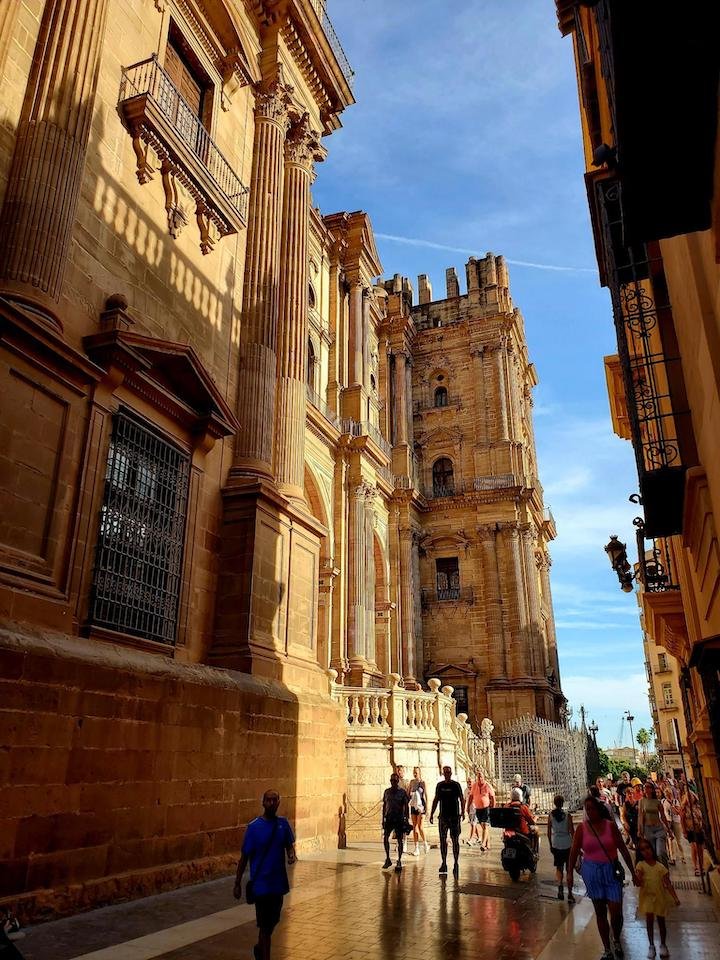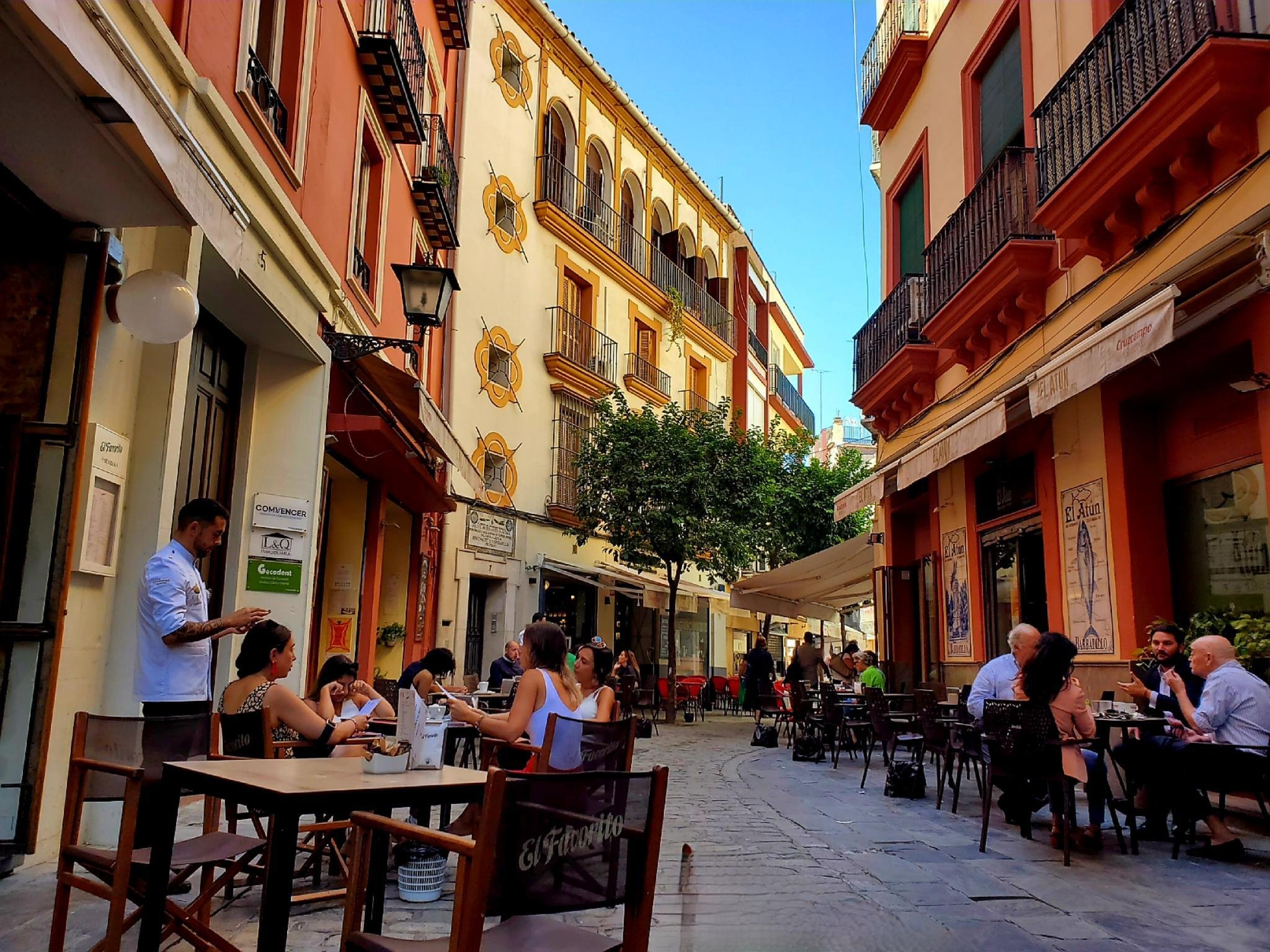Note: all photos taken by Selena Templeton, unless otherwise noted.
As I sit at Vino Volo, a quiet bar at Los Angeles International airport, an older woman sits next to me, and when we both receive our glasses of wine, she holds hers up to me and says, “Cheers to wherever you’re traveling to!” We clink and then chat for an hour about traveling (she’s on her way to Prague, I’m going to Spain — finally!).
This is what I want, I think as I pay my bill and then walk to the boarding gate. To connect with lots of interesting people on this adventure. As an introvert and a freelancer who lives alone, I sometimes get very hungry for these personal connections, the kind you make when out of your comfort zone, when not on autopilot. When not in your own familiar territory or communicating in your native language.
Madrid
After an eleven-hour flight from LAX in Los Angeles – in which I bribed Iberia for an aisle seat (okay, paid thirty bucks ahead of time for a seat choice) – I land at Adolfo Suárez Madrid–Barajas Airport in Madrid, Spain. The minute I step outside the building, one thing is clear: People smoke like chimneys here! Not inside (thank god), but outside airports, train stations, theaters, etc. you can usually find a crowd of addicts squinting through a gray haze.
The taxi stand, by the way, is the busiest and the most efficient I’ve ever seen. Line: 2 city blocks long. Wait: 5 minutes, if that.
Before I know it, I am in a taxi barreling down the highway towards Madrid’s city center. The 30-minute ride is quiet until the last 10 minutes, when the driver apologizes for the sudden onslaught of rush hour traffic.
“No hay ningún problema porque estoy de vacaciones y no tengo un horario,” (No problem, because I am on vacation and don’t have a schedule.) I say gleefully.
He asks me where I traveled from, and when I tell him the U.S., he says I speak Spanish very well. I thank him and tell him I have been taking lessons an am eager to practice, which prompts him to give me a run-down of what to do while in Madrid in very fast Spanish.
When we arrive at the hotel, the driver gets my suitcase out of the trunk, shakes my hand enthusiastically and welcomes me to the city. My god I think I’m going to like it here.
I check in to the four-star Hotel Agumar, “an ideal stay in the museum area of Madrid” (which I chose for its proximity to the train station) and then wander through Barrio de las Letras (an area where many writers, including Cervantes, used to live; you can visit Lope de Vega’s house which is now a museum) and Lavapiés (a trendy neighborhood with an untrendy feel).
La Fisna Wine Bar, Madrid
Finally, I stop in at La Fisna Wine Bar for a drink (recommended by Spain Revealed, a YouTube channel full of great videos on traveling around the country, how to order tapas, the best wine and other handy tips).
What a great bar this is – cute and cozy, with exposed brick walls. I order Suzzane, a delicious red wine from Rioja, and receive a complimentary dish of the biggest olives I have ever seen.
When the waiter switches to English upon hearing my non-native Spanish, I persist in Spanish and he soon buckles and switches back. I’m not about to let two years of Spanish lessons go to waste!
I sit there, my first night in Spain, listening to the hum of Spanish conversations all around me and can’t stop smiling.
By the way, I’ve been taking these one-on-one Spanish lessons from Laura, a native Spaniard and a fabulous teacher whom I found on Preply (not an affiliate link, just thought you might find it helpful), a platform for online language tutors.
I’d landed in Madrid at 2 p.m., which was roughly WTF o’clock California time, and because my body refuses to sleep unless it’s horizontal and it’s nighttime, by the time I go to bed, I’ve been awake for 36 hours. But then I get 12 glorious hours of deep, uninterrupted sleep, so woo-effin’-hoo!
Parque de El Retiro, Madrid
As I step out of a very refreshing shower, the lights go off (I later learn that the electricity went out in the whole hotel). So that means putting on makeup by the meager light that comes in from the window and illuminates only one side of my face. I cross my fingers and go out to explore the city.
I stroll through Parque de El Retiro (El Retiro Park), one of the largest parks in the city, which belonged to the Monarchy until the late 1800s. It’s 350 acres compared to, for example, Central Park’s 842 acres or Stanley Park’s 1,000 acres (oh my god, I just learned that Vancouver’s downtown park is bigger than New York’s!).
It is lovely – it contains lots of trails, a lake, a rose garden, many statues of royalty (leftover Monarchy-era souvenirs) and the Palacio de Cristal (a glass building used for art exhibits, pictured below).
Source: esmadrid.com
In the center of the park is also the Palacio de Velázquez, a modern art museum that is free, so I wander through it. There are about 10 “modern art” exhibits and a lot of empty rooms. (Come to think of it, maybe the empty rooms are also exhibits.)
By mid-afternoon I come across Sucre Salón de Té just across the street from the park and about two blocks away from the Prado. It is a lovely, rustic café (i.e. mismatched chairs) with bookshelves and artwork, where I have a delicious cup of tea and pretend to write in my travel journal while really eavesdropping on Spanish conversations.
Sucre Salón de Té, Madrid
When I say artwork on the walls, I mean artwork!
Tea consumed, artwork admired, feet rested, I leave the café and stroll through the narrow, cobblestone streets on my way to the Barrio de las Letras neighborhood (god, there are so many incredible buildings everywhere I go!) where I am going to take a tour.
The tour is the “Tapas and Wine: Small Group Literary Quarter Tasting Tour” by Devour Tours I’d booked prior to my trip. Run by the Spain Revealed folks, it’s recommended that you take this tour on your first or second day in town, because it’s an excellent introduction to the city. I heartily agree.
The 2.5-hour tour is fantastic! Turns out that it’s just me and a lovely (ok, third “lovely”, time to consult the thesaurus) retired couple (Anita and George), so we have an intimate tour led by the knowledgeable and friendly Liliana. She takes us to three tabernas (taverns):
Taberna El Economato, where we start with two types of vermut (vermouth) and tapas
Taberna de la Elisa, a more dimly lit place with great tile decor where we have two of Spain’s most famous red wines, Rioja and Rivera, plus tapas
Ferretería, located in a building from the 17th century that used to be a hardware store, where we have white wine and incredible croquetas and assorted cheeses (pictured below)
Source: Devour Tours (Madrid)
The next morning I wake up at 11:50 a.m., which is not only later than I’ve woken up since the morning after my high school graduation party, but it is ten minutes before my check-out time and an hour and ten minutes before my train departure!!
I get ready and pack in record time (a la Elaine from Seinfeld), check out (no late fee, phew!), speed-walk to the Estación Madrid - Puerta de Atocha train station lugging my rolly suitcase over uneven sidewalks, have to backtrack a block due to construction work, can’t figure out where to actually board the train (there are two buildings with no visible signs whose main floors consist solely of elevators going down), ask a nice man who gives me excellent directions, and am sitting on the train with ten minutes to spare.
Just as the train pulls out, it starts to rain, and I sit in my comfy first-class seat (hello vacation lifestyle!) and gaze out the window. Within about five minutes we are in the countryside, which is amazing, considering how big Madrid is. The landscape is mostly flat and, aside from Córdoba, where we briefly stop, we don’t pass through any cities or towns. I see only one tiny village off in the distance which consists of a handful of white houses at the foot of a hill and a small castle on the apex.
I thought, when I’d pre-booked my train ticket, that I’d ordered a meal, but somehow that technological skill of checking a box escaped me. That means watching everyone around me dig in to a hot meal with real cutlery and a fancy-looking box of chocolate (singular). I attempt to go to the café car on the train, but when the door to the next carriage doesn’t open, I just return to my seat.
Málaga
Three hours later, I am in Málaga. On the taxi ride to my Airbnb, I note that this city looks very tropical, very touristy and, because it’s a port city, I feel like I am on an episode of Love Boat.
My Airbnb is in the Soho neighborhood, blocks from the ocean and just on the southern end of the city center. The apartment is on a narrow, cobblestone street that looks like an alley (they all do, but they’re not, they’re proper streets). It’s quite lively with some vehicles (mostly delivery vans and taxis), lots of pedestrians and two busy cafés at the intersection fifty feet from the apartment. Thankfully, the soundproofing on the windows is the best I’ver ever (not) heard!
I stroll around the Centro Histórico (historic center) and wow. Beautiful, picturesque and definitely historic! The Catedral de la Encarnación de Málaga (partially pictured below), constructed between 1528 and 1782, is in the Renaissance architectural style but with a baroque facade.
Catedral de la Encarnación, Málaga
A vermouth in Málaga
I find a nice taberna (tavern) called Picasso where I sit outside and enjoy vermut and croquetas y patatas bravas (two dishes I am quickly become addicted to). It thrills me to speak in Spanish to the waiter and I secretly look down my nose at the American patrons who speak English (and just barely, at that) until the waiter says something I don’t understand and I meekly ask him to repeat it in English.
A café bombón in Málaga
After a solid 9-hour slumber (so far Spain wins for best sleep; I haven’t had a solid 8-hour sleep anywhere else for about a hundred years), I get curious about the ultra-popular café – Bar Atenas – right across the street from my Airbnb and go there for an early lunch. I have a café bombón (espresso and sweetened condensed milk, a beverage I am quickly becoming addicted to).
I also have a bocadillo mixto (“mixed sandwich” which is just code for “ham and cheese”; do they not mix anything else?), and is pretty standard fare for a Spanish breakfast or lunch.
Source: El Español
And although it is about 11 a.m., the guy sitting next to me is enjoying a caña (small beer). Right on!
Inspired by last night’s dinner at the Picasso restaurant, I walk to the Museo Picasso (Picasso Museum), which I assume will be dedicated to Picasso’s art. As it turns out, it is just a museum named after the artist (who was born in Málaga) but with very little of his works. (Note: I am 100% wrong about that. But, in my defense, all the new Picasso exhibits started literally days after I left.) Still, it is an enjoyable experience. It cost €1.50 ($1.60) to get in and, as I will discover over and over again, the building itself is as much a work of art as the paintings displayed in it.
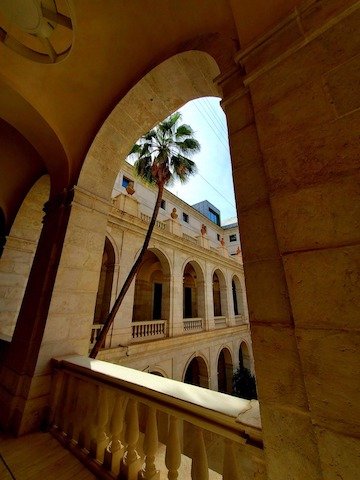
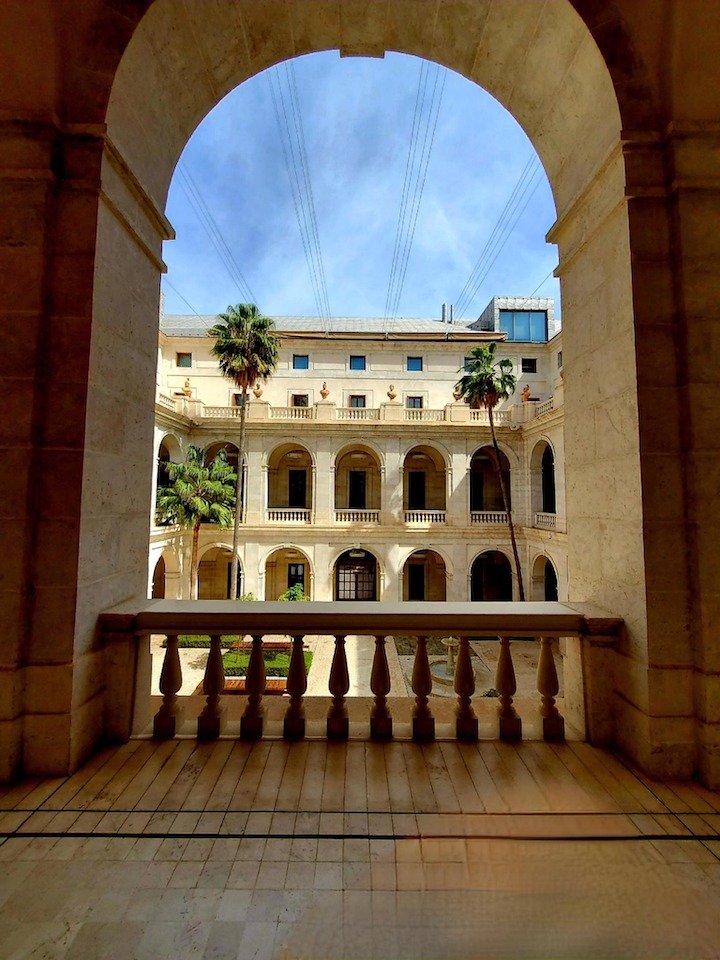
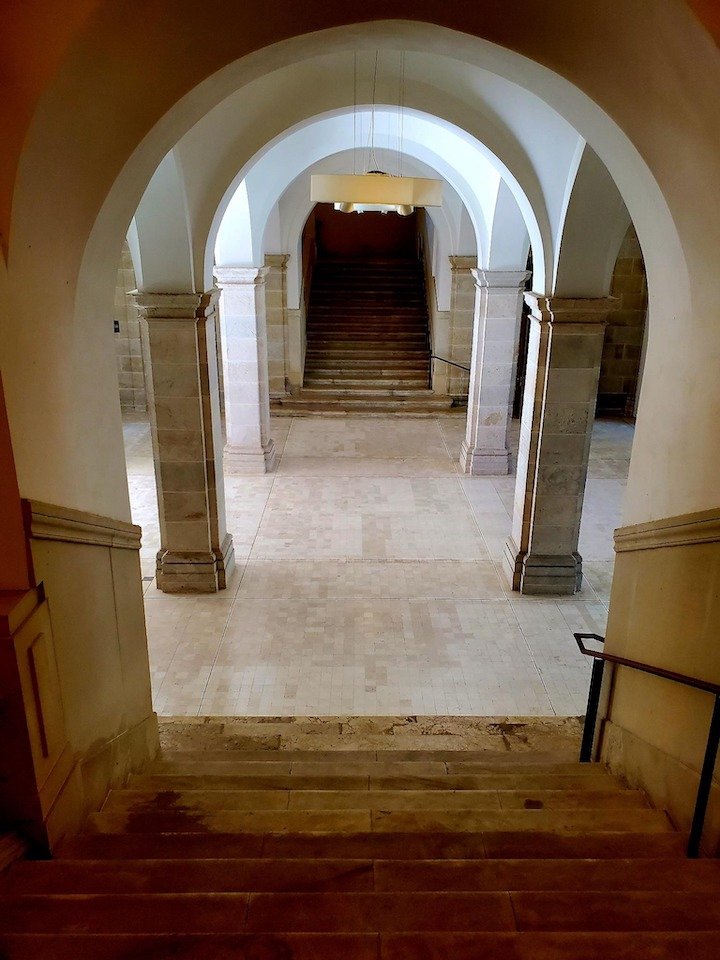
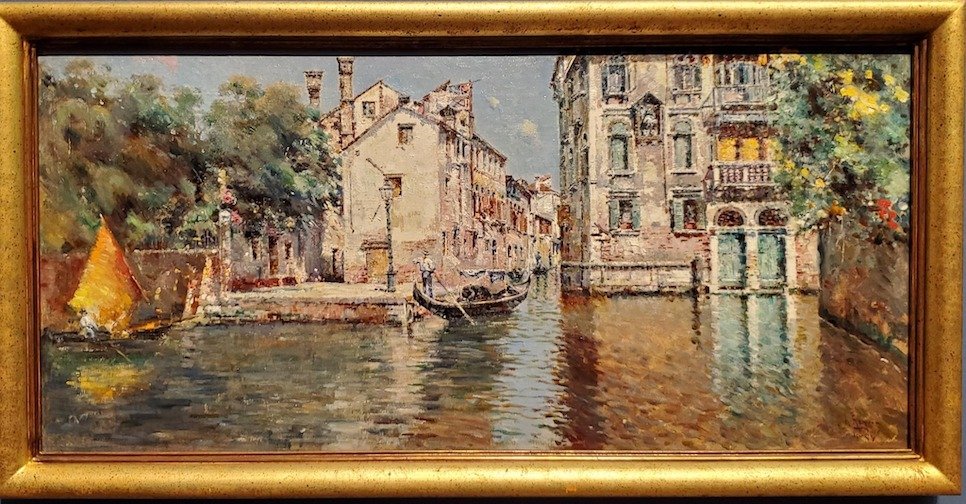
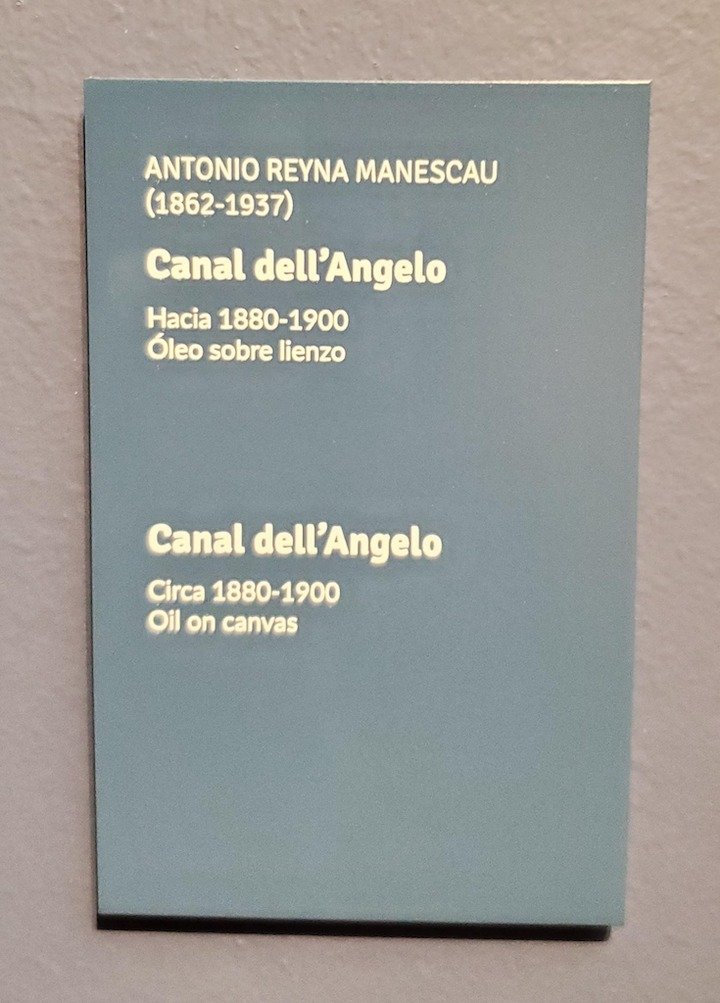
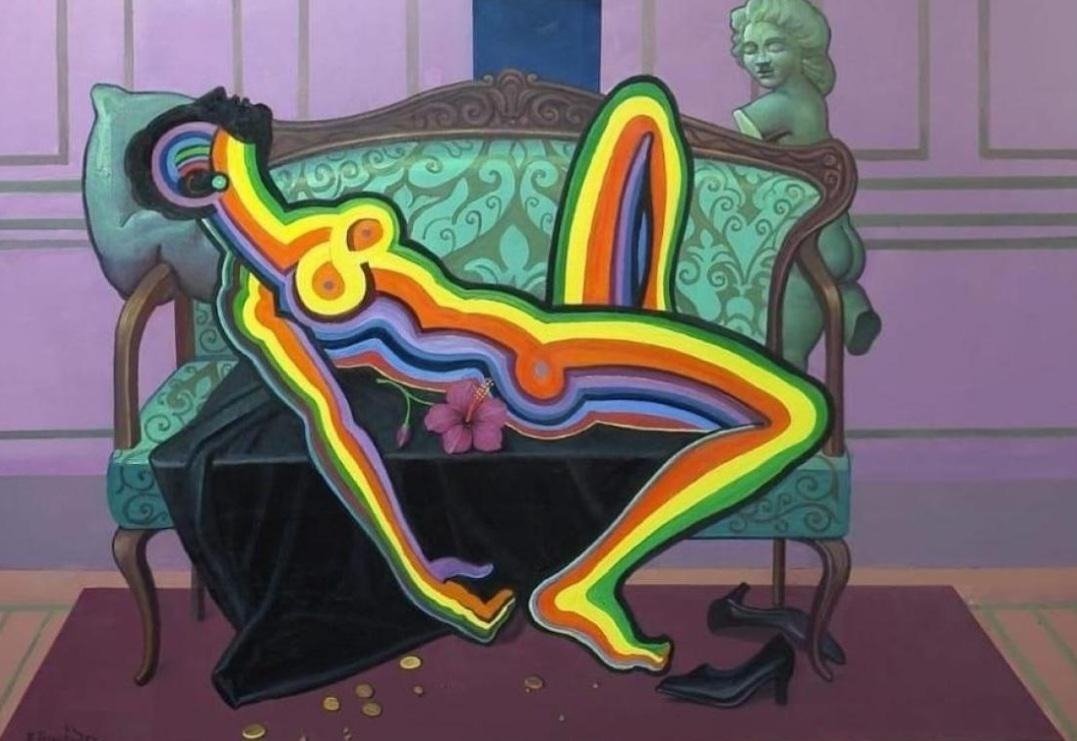
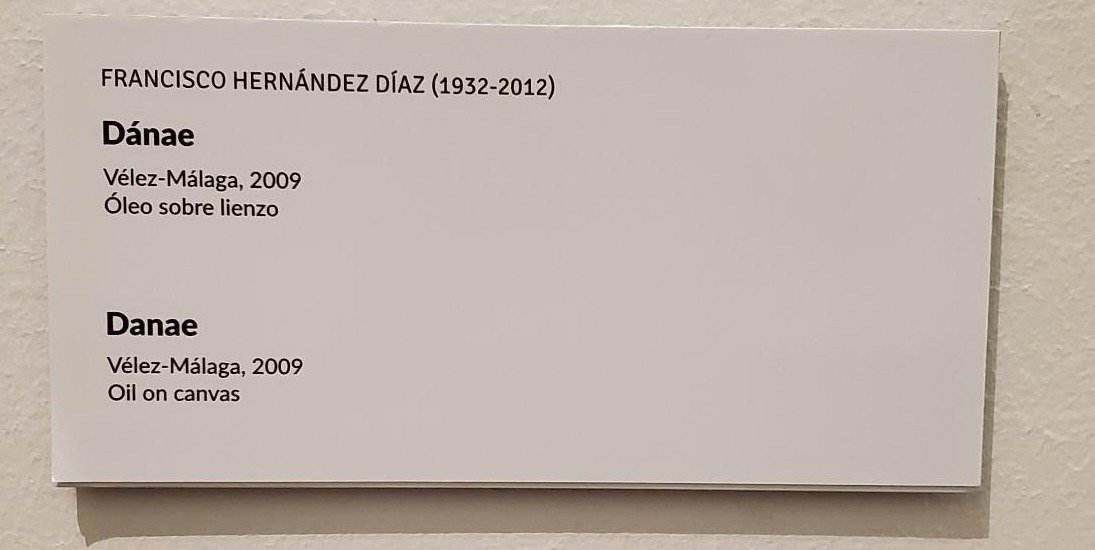
After that, I keep walking up to Castillo de Gibralfaro (Gibralfaro Castle), the ruins of a 10th century Moorish castle/fortress, about a mile hike up to the top of Mount Gibralfaro in 90F/30C heat. Once I get there, sweaty and heart pounding, it’s immediately worth it. There’s something so awe-inspiring and even moving in a mystical way about walking on the stone steps or running my fingers along the ramparts or ducking through arched doorways where the sentry used to walk/touch/duck thousands of years ago.
Salmon and cream cheese toast, and beer, Málaga
Needless to say, by the time I make it back down the mountain, I am extremely hot and thirsty. So, like any good Spaniard, I stop for a drink. I find a cervecería artesanal (craft brewpub) and sit outside in the shade with a sea breeze that almost makes it to me while I enjoy a delicious “eepa” beer – which I soon realize is an IPA beer!
Random observation: In Spain they usually pronounce English words like any Spanish word; hence, IPA = “eepa”, the band U2 = “oo-dos” and WiFi = “weefee”.
Along with the cerveza, I have a delicious tostado con salmón y queso cremado (thick toasted bread with salmon and cream cheese), which I still dream about to this day.
On my way back to the Airbnb, I come across a bookstore called Librería Luces which, of course, draws me in like a magnet. I browse the two floors, mostly for the experience of walking up and down the stairs with literary quotes on each step!
Librería Luces, Málaga
My final night in Málaga I venture out to a restaurant in Old Town called Vertical Wine Bar Málaga which is, THANK GOD, on a quiet, empty street just off the main pedestrian thoroughfare. Seriously, it’s a 13-minute hustle through the unrelenting crowds like a salmon swimming upstream, only the other salmon are all staring down at their phones as they walk so you have to do this carefully choreographed river dance to make it out alive. (I may have knocked over a kid or two.)
And music plays from many of the restaurants and shops, so everyone is talking at top volume to compete with it. Thus, the quiet restaurant on the quiet street is a very welcome respite.
Random observation: 99% of the time that music is playing (taberna, café, restaurant, store, taxi), it is American pop music.
Moriche wine at The Vertical Wine Bar, Málaga
The Vertical Wine Bar is empty when I walk in, so I get to have a very nice, relaxed conversation (en español!) with the waiter, Javier, as he takes me on a tour through the menu and recommends what turns out to be the most exquisite meal I have in Spain.
In fact, I later get to compliment the chef directly, and I tell her that her culinary creations are “como una orquesta en mi boca!” (like an orchestra in my mouth). And the wine, ooooh. I ask for recommendations from the area and get one glass of El Sueño and one of Moriche.
As I finish a magnificent meal fit for a queen (a very poor queen, come to think of it, but a queen nonetheless) — three or four fancy tapas plus wine, dessert, port, coffee — I sit back with a sigh and reach into my purse for my money. And freeze. It’s not there. I call Javier over and with burning cheeks explain that I left my wallet in my other purse, but that my Airbnb is only 10 minutes away (I will be speed-walking) and I can leave my driver’s license with him and, and, and –. He graciously says that won’t be necessary, takes down my phone number, and smiles at me as I hit the door running like I’m in a marathon and the gun just went off.
Twenty minutes later I’m back, not only with the €40 for the meal, but with a €20 tip for him. He refuses it at first (Spain does not have a tipping culture), but I insist because he was so kind to me when another waiter might not have been. He finally accepts it and thanks me and he, the other waitress and the chef all tell me they hope to see me again soon.
I have a fitful sleep that night because I think I’ve busted my international converter plug and thus can’t charge my phone (on which I have my e-tickets for train and plane, plus Google Maps is a traveler’s best friend). Also, I realize that don’t know where or how to get a taxi. But the next morning as I go out for breakfast, I see a line of taxis idling at a taxi stand at the end of the block. One problem solved! I head to the Málaga María Zambrano Train Station.
On this train trip, I am looking forward to a meal in my first-class seat. Nope. Not only did I not order a meal, but I bought an economy-class ticket. (Honestly, was I drunk when booking these train trips??) Economy feels like I am riding a school bus at 3 p.m. One woman (at least mid-fifties) is walking up and down the aisle singing out of tune. The person behind me is listening to a radio without headphones. A group of women nearby is talking and cackling – literally; this is not a metaphor – loudly. And the two guys in front of me and the guy next to me are rough-housing with each other and speaking in German so I can’t even eavesdrop.
Sevilla
So, I accidentally get off the train one stop too early (who knew Sevilla had two train stations??).
Instead of Sevilla Santa Justa, I get off at Sevilla San Bernardo, a small station with no line of taxis waiting out front. Not even one. Not even a random car. Just an empty bus loop. Thanks to Google Maps (and my 35% battery life), I find a bus – actually, a surface tram – that goes very close to my hotel. But the machine to buy tickets isn’t working! And the train is due in 3 minutes.
Luckily, there is a nice-looking young couple at the stop, so I ask them for help, but even they can’t figure out the damn machine. So the woman says “Te invitamos” (“our treat”). On the tram, you pay by pressing your card against the reader – she presses it once, twice (her and hubby), three times (for me!). I try to give her money for it, but she shakes her head with a smile and says, “No, no it’s only 35 cents!”
On the tram ride into Casco Antiguo (Old Town), I immediately fall in love with Sevilla. It’s like Old Town Málaga, but smaller, calmer and less like a fake Las Vegas European city.
Note: This video of the tram from the outside was taken later. Clearly, I am not inside it.
I get off at the Plaza Nuevo stop and walk about three minutes to Hotel Maestranza, a boutique hotel in a storybook setting.
Source: Hotel Maestranza
Here’s the view from my hotel room:
View from my room in Hotel Maestranzo, Sevilla
I am deliriously happy to discover, by the way, that my phone charger works, and I juice that baby up before heading out.
As in Madrid, my first night here in Sevilla I take a Devour Tour – “Seville Tapas, Taverns & History Tour” – to get to know the city better. This time it is a bigger group (there are 10 of us, plus our guide Manuel, a thoroughly friendly, fun and knowledgeable Sevillano).
Everyone in the group is a native English speaker who know few, if any, Spanish words, and I can’t help wonder why you would travel to a foreign-speaking country and not learn at the least the basics of the language. Anyway, I wind up chatting quite a bit with two lovely (that’s four; jesus, take a shot every time I use “lovely”) couples, Cath and Chad from Australia, and Heidi and Adrian from the UK, as we walk from taberna to taberna.
Bodega Diaz Salazar, Sevilla
The first tapas bar we hit originally opened in 1870, and from there we walk around Casco Antiguo eating and drinking our way through about ten tapas and six copas de vino (glasses of wine – all of which are fairly small compared to American pours, so quit judging me!). One of my favorite discoveries is vino naranja (orange wine), mmmm! In fact, I liked it so much that after the tour when the two couples mentioned above and I went back to Bodega Díaz Salazar for drinks, I ordered orange wine again (and again).
Quick note on orange wine: It’s not, as I assumed, a new type of wine. It’s actually an 8,000-year-old wine that’s just become really popular in recent years. It’s made with white grapes with skins intact (unlike white wine) to create an amber-colored wine. So no actual oranges involved. The ones I tried were on the sweet side with just the faintest hint of orange flavor due to the natural aromatic compounds in the grape skins.
Random observation: Aside from one or two fancier dinners or drinks, I never paid more than about €3-5 ($3.20-5.30) for a glass of wine, €1.5-4 ($1.60-4.25) for a glass of beer and €5-15 ($5.30-16) for a meal.
The next day after a GREAT sleep in a super comfortable bed in the quiet hotel, I set out to explore more of Sevilla. I look for a breakfast place and wind up having lunch by the time I find a café that doesn’t have a line up outside. Along with actual food (tostado de jamón y aceite de oliva – toast with ham and olive oil), I try chocolate and churros.
Chocolate and churros, Sevilla
This – basically donuts (or “fluted sticks of fried dough”) and melted chocolate – I am told, is a typical Spanish breakfast. Which makes my jaw drop, until I realize that the American/Canadian version is pancakes drizzled in syrup. It is delicious, but too sweet for brekkie.
Setas de Sevilla
As I sit at the outdoor table, I stare across the street at the most, um, interesting structure I’ve ever seen. (Well, almost. Every city’s got their “oh, well, isn’t that…unique” building. Here’s L.A.’s.)
I ask the waiter what it is, and he tells me that it’s called Setas de Sevilla (Mushrooms of Seville), a mostly wooden structure in the Plaza de la Encarnación (aptly subtitled “modern square with a giant art piece” in Google Maps). I can’t figure out what the building actually is, so when the waiter leaves I Google it. (Still have no idea what it is, but I do learn that it used to be a parking lot and it’s the largest wooden construction in the world.)
Then I go off on what turns into a 3-hour tour (haha). Walk.
I circle but do not enter the Catedral de Sevilla (for those who do not know me well, I am allergic to standing in lines, particularly on vacation), and accidentally time travel back to ye olden horse ‘n’ carriage days.
Catedral de Sevilla
I stroll across the Patio de Banderas, home of Antonio Banderas. Kidding. (I wish!) The best descriptions I can find for it are: “The Patio de Banderas is currently rectangular in shape” and “It’s a pleasant small square featuring a fountain and orange trees.”
I visit the Torre del Oro, a military tower built in 12th century on the Río Guadalquivir. There is a small maritime museum on the top floor that you get to by walking up a very tall and very narrow spiral staircase for about a year.
Source: Seville City Guide
Then I cross the river, see the (outside of) Real Parroquia de Señora Santa Ana, a 13th-century Catholic church with Gothic-Mudéjar architecture, do not come across the Librería Entre Líneas (Between the Lines Bookstore) despite what Maps insists, and have a tough time finding a place for lunch since many cafés and restaurants are closed during the, well, lunch hour. You know, siesta time and all. Finally find a bar where lunch consists of a cerveza and a handful of peanuts. Don’t care, as it is a relief to sit down in the shade after a three-hour walk in 30C/90F temps.
That night, back at Hotel Maestranza, I fall into bed and am out like a light until 11 a.m. the next day (I’m telling you, this sleeping business in Spain is some kind of damn miracle!).
Upon awakening, I know I’m not done with Sevilla yet, so I add another day to my itinerary. Fortunately, the hotel has an availability, the train ticket is easy to switch online and my Airbnb in Madrid isn’t going anywhere.
Random tip: In Spain there are four major train companies (AVE, Avlo, Renfre and Iryo) and the easiest way to book a ticket is at Trainline, a site that lists all four train lines together so you can compare prices, routes, times, etc.
While I am at the front desk of Hotel Maestranza, I ask the woman working there (Alba) about using the informal tú versus the formal usted with people you don’t know. According to my high school Spanish, you’re supposed to always use usted with strangers. But Alba says that you generally use tú except when you clearly want to convey respect, like in business or with elderly people. Waiters will often start with usted until the customer uses tú.
Jazzed about my extra day in this beautiful town, I walk a block or two until I discover El Favorito, a lovely (shot time!) café on a picturesque street:
El Favorito, Sevilla
I notice that this place, like many others, has signs on the outdoor tables that say autoservicio, which confuses me because that means “self service.” And there are definitely waiters working the tables. After a delicious croissant de jamón y queso, jugo de naranja and café bombón, I ask the waitress about that. She explains that it means you go in to the restaurant to order and then the wait staff bring your food out to you. Although often they will come take your order if it’s not that busy. Hence my confusion.
Physically and linguistically sated, I set off on a 20-minute walk to the Plaza de España, which everyone said was a must-see. Really? I think when I reach it. It’s a great-looking building, but so are most of the buildings in Spain.
Plaza de España, Sevilla
And then I go inside. My god.
The Plaza de España was built in 1929 for the Ibero-American Exhibition, is about 50,000 square meters and the styles of architecture and design are a mix of Baroque, Renaissance and Moorish. There are 52 benches around the semi-circle plaza with tile mosaics at each one, which depict the 52 Spanish provinces. The plaza has a canal with boat rides, bridges over the canal and a big fountain in the center.
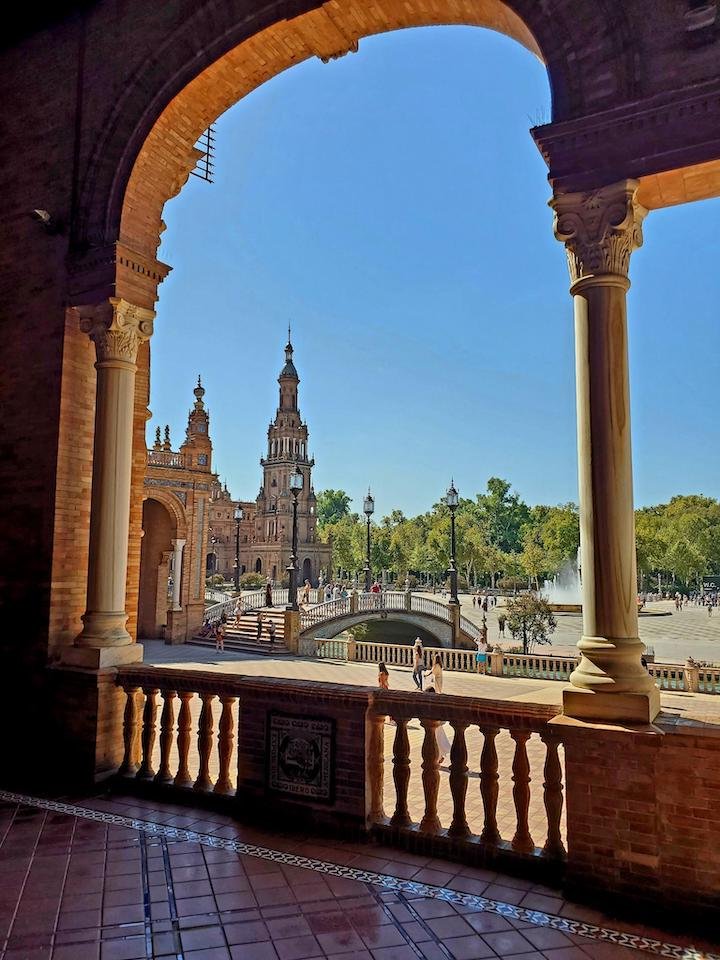
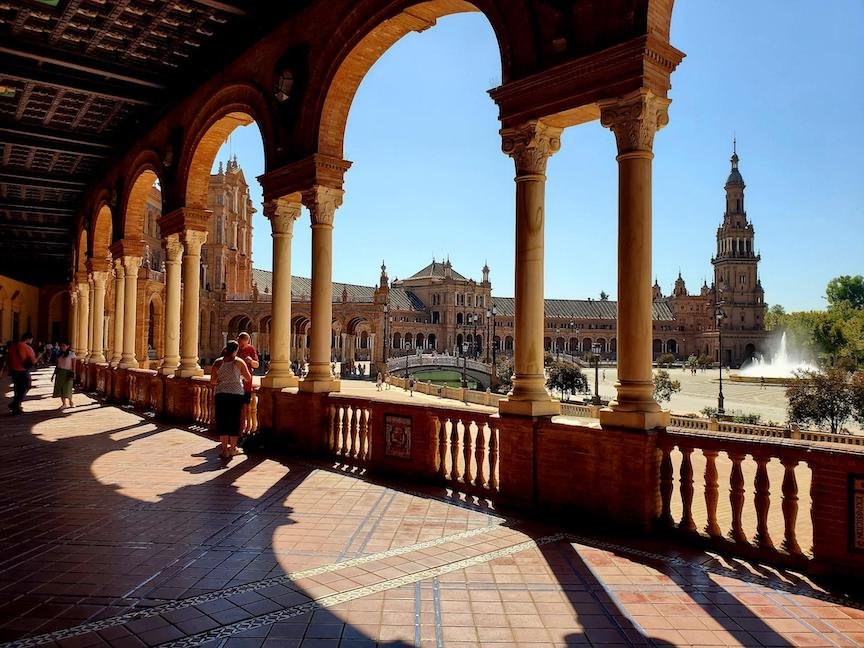
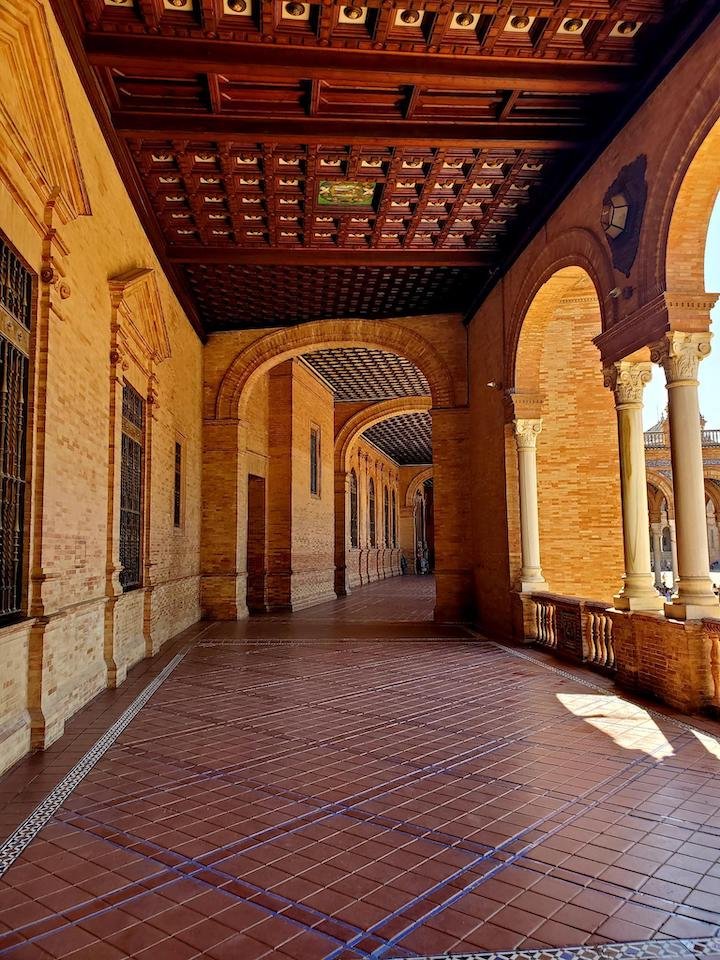
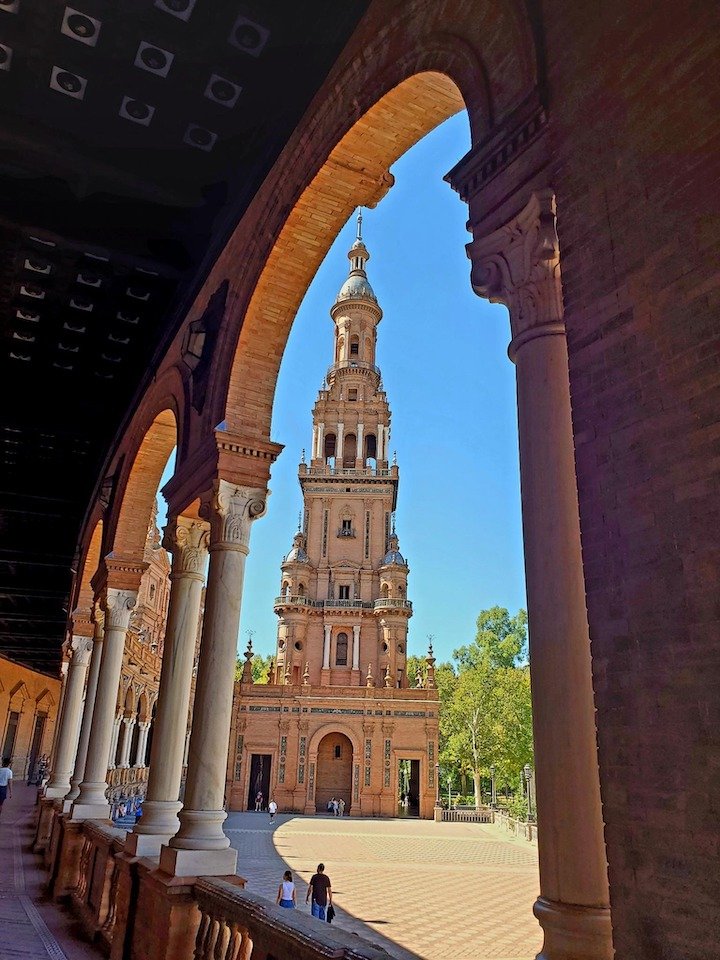
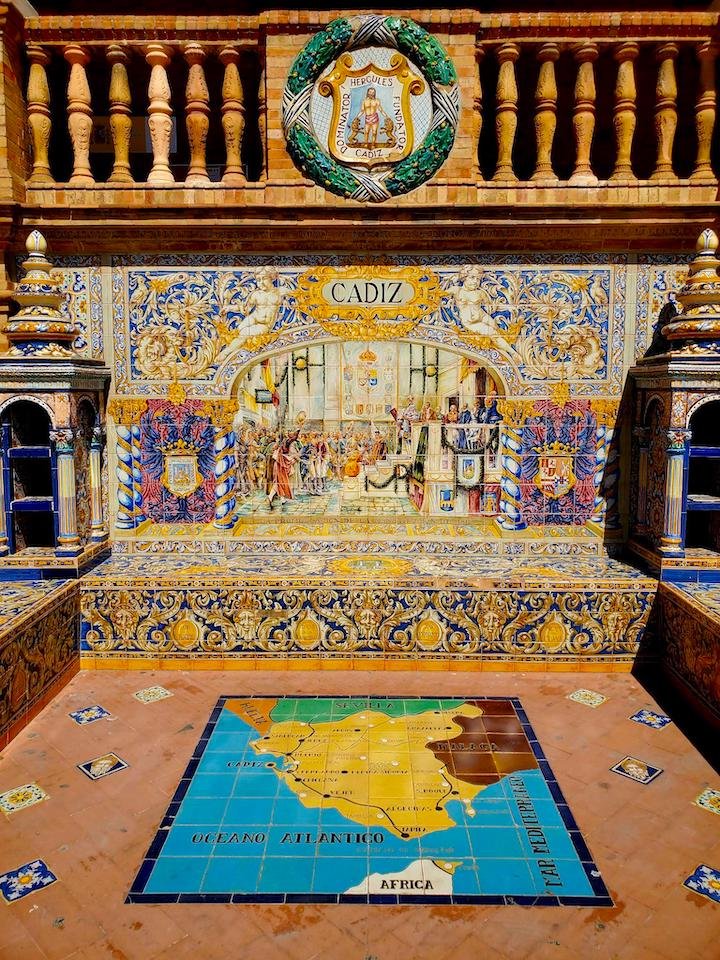
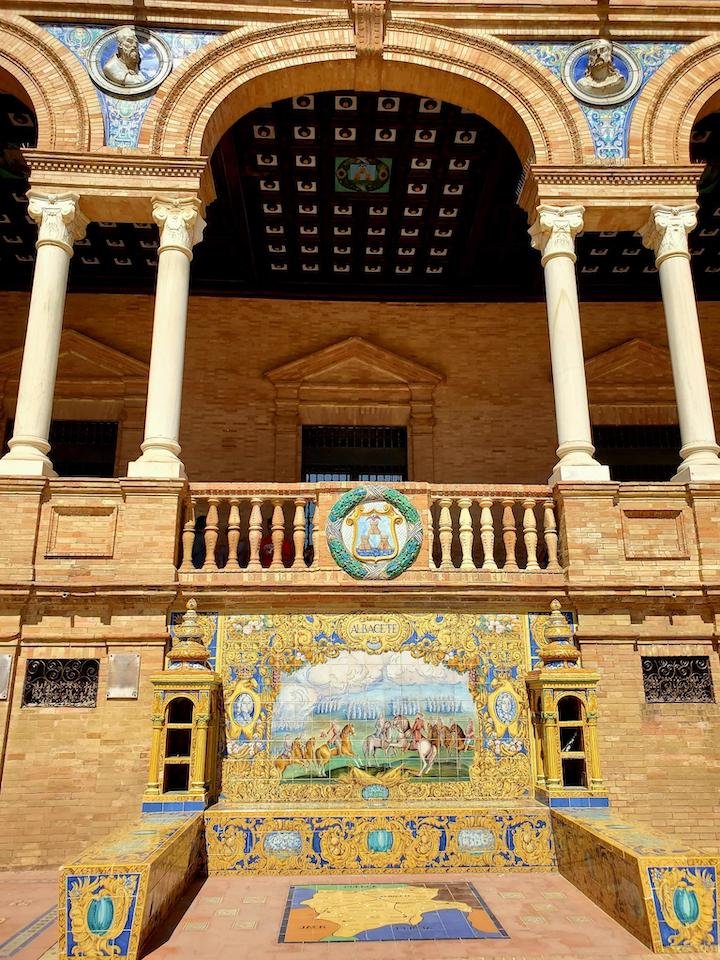
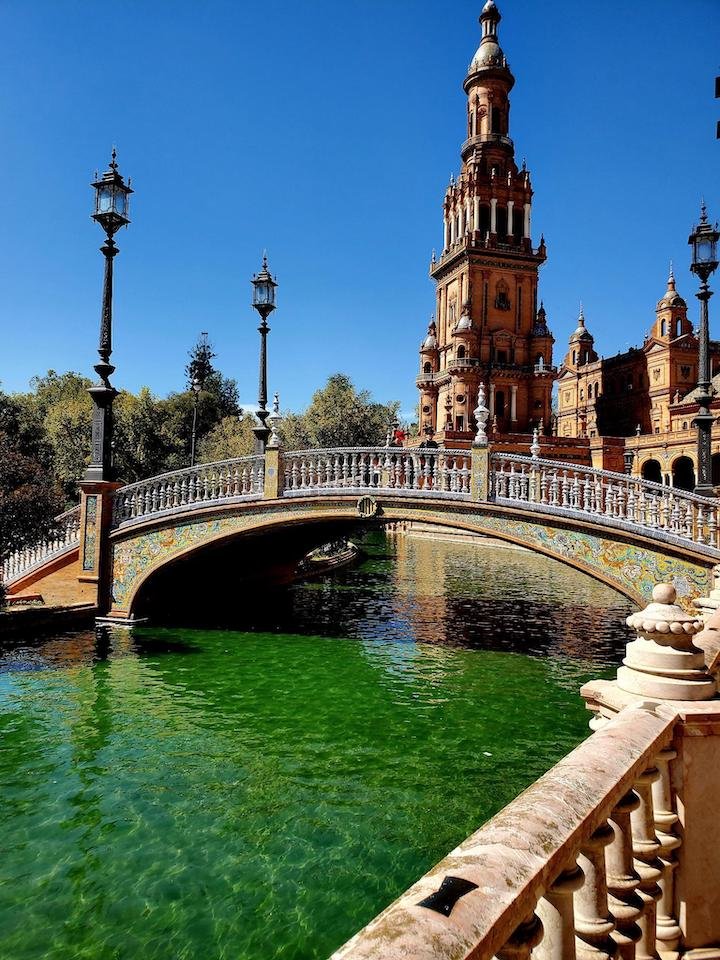
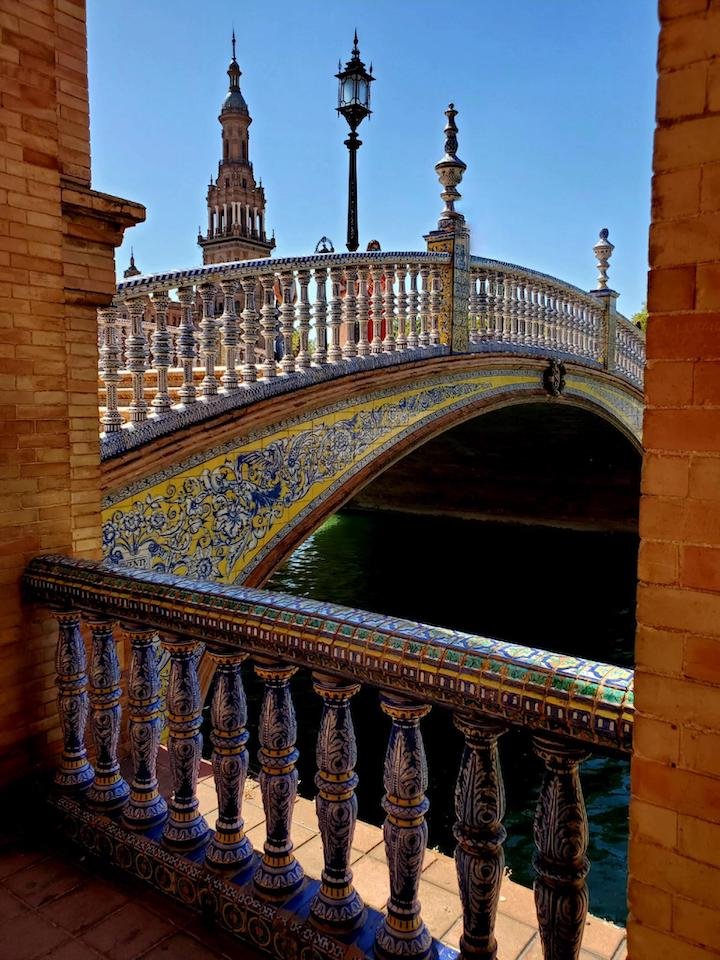
Plus, Lawrence of Arabia and Star Wars: Attack of the Clone were filmed here.
When I leave the plaza, I walk through the Parque de María Luisa on my way back to the hotel – and it’s big enough that I feel like I have left the city.
Parque de María Luisa, Sevilla
Back at the hotel, I change and then head out for dinner at Bodegas Díaz Salazar (one of the places I went to on the tour my first day here), which was first opened as a wine shop (bodega means winery) in 1908. I have croquetas de jamón, the best salad I’ve had in Spain, and two glasses of vino naranja. Yum!
🇪🇸 👉 Para leer la siguiente parte en español, haga clic aquí. 👈 🇪🇸
After dinner I head out to a flamenco show – my first one ever! It’s the “Seville: Live Flamenco Dancing Show” at the Teatro Flamenco Sevilla (according to the ticket receipt. But the physical place is called Teatro Pathé. So let’s just say I was at a theater.).
Teatro Pathé, Sevilla
As I enter the theater, the usher, an older gent of 70-75, looks me in the eyes and says (in Spanish), “You are a very sensitive person, so you will be very moved by this.” He didn’t say anything of the sort to anyone else, just told them where to sit.
I say something like “Yeah, ok, I hope so” and he continues: “You have an open heart and flamenco is very passionate, so it’s okay to cry.” Wow.
I thank him for the advice and then go my seat, stepping over the row of seats up to the next one like the cultured dame that I am – and nearly take a nosedive when the tip of my shoe catches on a seat.
“Wow, you made it!” says the man sitting one row up.
I grin: “You didn’t realize that I was the opening act, did you?”
I wind up talking to the man and his wife, John and Rachel, a super lovely (you must be drunk by now) retired couple from Manchester, England who have been traveling all over Spain. They love to dance (met at a dance class!) and have seen five flamenco shows so far on this trip.
Source: Teatro Flamenco Sevilla
So, I do, indeed, cry during the show. It is beautiful and intense and passionate and a little mysterious with the dry ice creating a haze across the stage. It’s made up of about six vignettes with various combos of the four women and three men dancers (and one man is just on guitar).
On my way out, the same usher is standing in the lobby bidding people good night, and asks how I liked the show. I say that I absolutely loved it and yes I did cry and boy I had no idea how moving this dance would be and then I’m crying again and he hugs me. As the crowd of people disappears out the door, he asks if I’d like to go for a walk and talk.
So for about an hour, I walk with Joaquin, this well-dressed older Sevillian gent, through the narrow, mostly empty cobblestone streets as we talk (did I mention: in Spanish!!). He is very observant and reads me like a book, telling me I have a big open heart but no one to give my love to and that causes some pain or sadness or frustration.
“But don’t give up,” he says. “Don’t close your heart just because some people can’t handle your deep emotions. That would be a shame. Just be yourself and be patient.”
Streets of Sevilla at night
As we stroll, he shows me some churches that have Christian, Jewish and Moorish details all together on the one building, back when these three religions were all able to peacefully and respectfully co-exist. For some reason, this makes me cry and Joaquin hugs me again. It’s not that I am sad, just emotional – the flamenco opened that up.
Finally, we say our goodbyes, I tell him I will never forget him, this sweet angel of Sevilla, and I walk back to my hotel.
Laura, who works the night shift at the front desk of Hotel Maestranza, asks me (as she does every time I walk through the door), “¿Qué has experimentado hoy?” (What have you experienced today?) I tell her about the flamenco show, getting teary-eyed all over again, and she tells me that she, too, gets emotional when watching flamenco because she, too, is sensitive. She smiles kindly and says she is glad I have had that experience, and I feel determined in that moment to follow Joaquin’s advice and not hide my deep emotions so much.
This will be the last time I see her, so I hang around the empty hotel lobby at close to midnight and chat a bit more, thank her for her kindness and for making my stay in Sevilla so wonderful, and then head upstairs to my room.
I sleep a solid 8.5 hours, then breakfast at the nearby El Favorito again, this time having tortilla y café bombón, served by a very friendly waiter named Javier who knows perfectly well the value of a Yelp review.
Museo de Bellas Artes, Sevilla
Then I walk to the Museo de Bellas Artes (Museum of Fine Arts), which was built in 1594 for a convent and turned into a museum in 1835. It houses art from the Middle Ages, Renaissance, Baroque eras and early 20th century, including from artists such as Bartolomé Esteban Murillo, Domḗnikos Theotokópoulos (aka “El Greco”), and Diego Velásquez. As always, the building is just as spectacular as the art.
Back at Hotel Maestranza for the last time, Alba checks me out and I thank her for a wonderful stay at this beautiful hotel, and tell her I am grateful for all her help and friendliness. She says she wishes that all guests could be as lovely (her word, but take a shot anyway!) as I’ve been and bids me safe travels.
I wait at the front door with my suitcase for the taxi that Laura booked for me last night.
Next, I’m off to Madrid and Toledo. Click here for part 2 of My Adventure in Spain!
IF YOU ENJOYED READING THIS TRAVEL BLOG, CHECK OUT SOME OF MY OTHER ADVENTURES:







